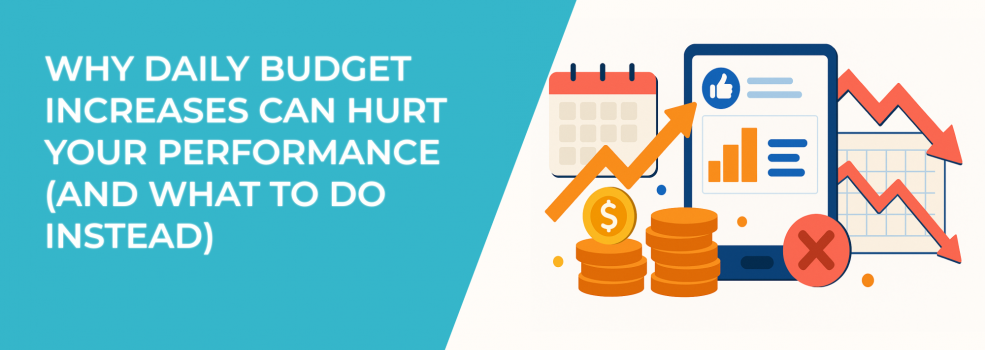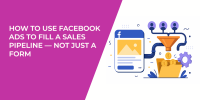Scaling Facebook ads feels like the obvious way to grow sales. More budget means more impressions, right? In theory, yes. In practice, advertisers often see the opposite: higher costs, lower conversion rates, and inconsistent delivery.
If you’ve ever increased your daily budget overnight only to watch your cost-per-result spike, you’ve run into one of the most common traps in Facebook advertising. But why does this happen, and how can you avoid it?
This guide will break down the real impact of daily budget increases, why the algorithm struggles to adjust, and what you should do instead to scale sustainably.
Why Sudden Daily Budget Increases Hurt Performance
Facebook’s advertising system is built on machine learning. Every time your ad runs, the algorithm collects data about who clicks, who converts, and who ignores it. Over time, it gets better at showing your ad to the right people.
Now imagine doubling your daily budget overnight. The algorithm is suddenly told to spend twice as much money — and it has to find twice as many people, fast.
Here’s what typically happens when advertisers make large budget jumps:
- Learning phase resets. The algorithm has to search for new conversion signals in a bigger pool of people. Here’s a deeper dive into
-
Costs rise. The system spends more aggressively, often on less qualified impressions.
-
Performance drops. CPC (cost per click) goes up, conversion rates go down, and ROAS takes a hit.
Example: an e-commerce brand running a $100/day ad set with a steady $5 cost-per-purchase decides to jump to $200/day. Within 48 hours, their cost-per-purchase rises to $9, and the campaign enters “Learning Limited.” Instead of doubling sales, the brand burns extra budget for worse results.
The problem isn’t just the bigger spend — it’s the sudden change that confuses the system.
How Facebook’s Algorithm Thinks
To understand why budget jumps hurt, it helps to see how Facebook’s system works.
Think of the algorithm as a scientist running experiments. It needs a stable environment to collect data and refine predictions. The more consistent the conditions, the more accurate its results.
When you suddenly increase your daily budget by 50–100%, you’ve changed the experiment conditions. The system is now forced to find a wider audience — many of whom don’t behave like your original converters.
The outcome? The data becomes noisy, results are unstable, and the campaign struggles to regain its footing.
The same logic explains why you sometimes see warnings like ‘Ad Set May Get Zero’ — if that’s been puzzling you, here’s a full guide on why that message appears and how to fix it.
Real-world comparison: it’s like running a restaurant where you know your regulars love a few specific dishes. If 50 new customers walk in all at once, and you suddenly have to guess what they want, you’ll make mistakes. Over time, you’ll learn their preferences, but in the short term, the quality suffers.
That’s exactly what happens with Facebook ads when budgets spike overnight.
A Smarter Way: Gradual Scaling
The safest way to grow is through incremental increases. Instead of doubling your daily budget overnight, aim for 10–20% increases every 3–4 days. This pace gives the algorithm enough room to adjust without resetting performance.
Example scaling path for a $50/day budget:
-
Day 1: $50,
-
Day 4: $60,
-
Day 7: $72,
-
Day 10: $86,
-
Day 14: $100.
At first, this may feel slow. But slow scaling protects your cost-per-result. You’ll also maintain more stable delivery, which means fewer wasted impressions and stronger long-term growth.
Pro tip: if you’re scaling into busy shopping seasons (Black Friday, Christmas, etc.), start your gradual increases weeks ahead of time. This ensures the system stabilizes before competition drives CPMs higher.
Tips for Scaling Without Breaking Performance
Daily budget increases aren’t your only lever for growth. In fact, relying solely on them is one of the riskiest scaling methods. Here are practical strategies advertisers use to scale smarter.
1. Use Campaign Budget Optimization (CBO)
Instead of setting fixed budgets at the ad set level, let Facebook allocate your spend across ad sets automatically. This feature, known as Campaign Budget Optimization (CBO), reduces volatility because the system adjusts budgets toward ad sets that are performing best in real time.
Why it works: Facebook has far more visibility into user behavior than you do, and it can detect performance shifts faster than manual adjustments allow. CBO essentially ensures that money flows to where it’s working hardest.
Best for: campaigns with multiple ad sets targeting different audiences or creatives.
Example: suppose you’re running three ad sets at $30/day each. Switching to CBO with a $90/day budget allows Facebook to prioritize the ad set that’s converting the most. Instead of wasting money on weaker ad sets, the system pushes more spend into your winners — without requiring you to constantly adjust budgets manually.
2. Duplicate Winning Ad Sets
When you find an ad set that’s performing well, don’t force it to absorb a much bigger budget overnight. A safer approach is to duplicate the winning ad set and give the copy its own moderate budget.
This way, you keep the original running at the same pace while testing how the duplicate performs under slightly higher spend. If it delivers consistent results, you can keep scaling both. If it falters, your original ad set continues to perform, protecting you from major losses.
Pro tip: always monitor duplicated ad sets closely for overlap. Too much overlap between identical ad sets can lead to audience fatigue faster than you expect.
3. Expand Audiences Gradually
A common mistake advertisers make is throwing more budget into a small audience. This often leads to higher frequency and ad fatigue. Instead, expand your audience gradually so it can absorb more spend naturally.
Practical ways to expand your audience:
-
Broaden your geographic targeting by adding one new region at a time.
-
Expand your age range by 5–10 years to open up fresh reach.
-
Layer in one or two closely related interests that align with your product.
Example: if you’ve been targeting 25–35-year-olds in the U.S., consider adding 36–40-year-olds or opening up to Canada as your next logical step. These small expansions allow you to scale spend without shocking the algorithm or burning out your original audience.
4. Build Lookalike Audiences
Once you’ve collected at least 500–1,000 conversions, lookalike audiences become one of the most powerful tools for scaling. They allow you to reach new people who share characteristics with your best customers.
Lookalikes give you access to large, scalable pools while staying connected to your core buyers. You can create multiple tiers, such as 1% (closest match), 3%, or even 10% (broader reach).
Example: an online store that has 2,000 purchase events can build a 1% lookalike audience based on those buyers. This new group is much larger than the original seed audience but still highly qualified, which makes it ideal for scaling campaigns.
If you’re not sure how lookalikes stack up against other options, check out our breakdown of custom vs lookalike audiences to see which one aligns best with your goals.
5. Refresh Creative Frequently
Scaling isn’t just about budgets and audiences. Ad fatigue is one of the silent killers of performance. As your ads are shown more often, people stop responding to them. Click-through rates drop, and costs rise.
To prevent this, introduce new creative assets regularly. That could mean swapping images, testing new ad copy angles, or trying different formats like Reels or Carousels.
Best practice: refresh your creatives every 2–3 weeks when scaling aggressively. Even small tweaks — such as changing background colors, highlighting a new benefit, or reordering carousel cards — can extend the life of a campaign.
Refreshing creative isn’t optional when scaling, because ad fatigue creeps in quickly — here’s how to spot ad fatigue early and fix it fast.
6. Test Lifetime Budgets
While daily budgets give you more control, they can sometimes lead to volatility when scaling. An alternative is to try lifetime budgets with a clear start and end date.
Why does this help? A lifetime budget gives Facebook flexibility to spend more on days when performance is strong and pull back when it’s weaker. This “ebb and flow” can smooth out results and make scaling less risky.
Example: instead of running a campaign at $50/day for 14 days, set a $700 lifetime budget. The system may spend $40 one day and $60 the next, depending on where it sees opportunity. Over time, this flexibility can improve cost efficiency.
7. Scale Retargeting Faster Than Prospecting
Prospecting campaigns require careful, gradual scaling because you’re targeting cold audiences. But retargeting campaigns are different — they’re built on warmer audiences who already interacted with your brand.
This means retargeting often tolerates larger budget increases without the same level of performance disruption. For example, you might safely double a retargeting campaign budget to capture more low-hanging fruit while keeping prospecting increases at 10–20%.
Pro tip: don’t neglect retargeting creative. Even warm audiences get fatigued. Rotate offers (discounts, testimonials, reminders) to maximize results.
Retargeting is one of the safest areas to scale aggressively — here’s a step-by-step on how to set up Facebook retargeting if you haven’t built those audiences yet.
Final Takeaway
Daily budget increases can hurt your performance because they disrupt Facebook’s learning process and force the algorithm to re-adjust. Instead of rushing growth, use gradual increases, expand your audiences strategically, and support scaling with fresh creatives.
When you respect the pace of the system, your campaigns deliver consistent results. That’s how you scale Facebook ads profitably — not with sudden leaps, but with smart, steady moves that compound over time.

